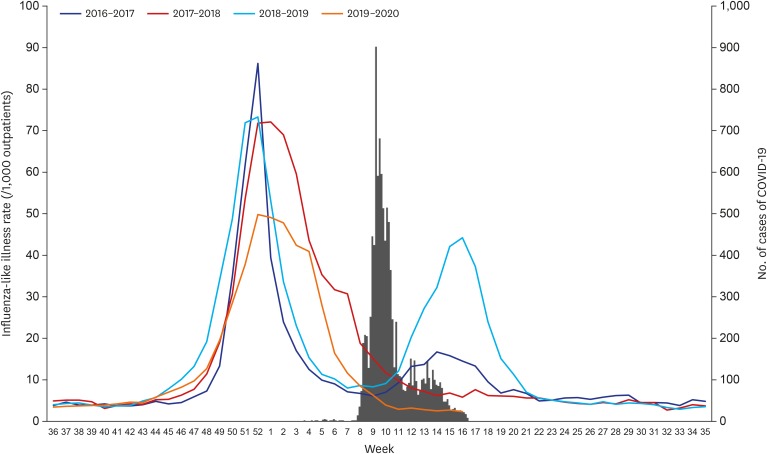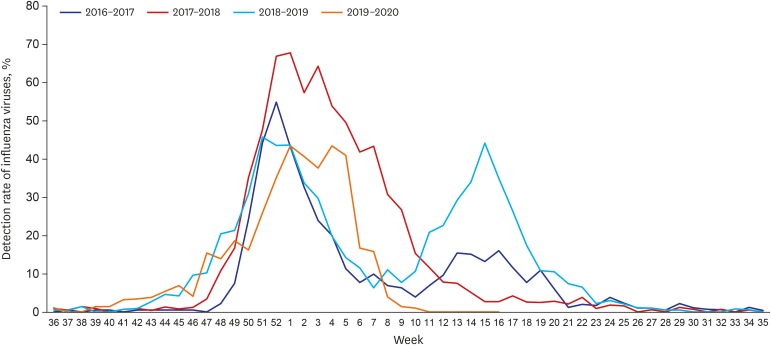J Korean Med Sci.
2020 Apr;35(19):e182. 10.3346/jkms.2020.35.e182.
Social Distancing against COVID-19: Implication for the Control of Influenza
- Affiliations
-
- 1Division of Infectious Diseases, Department of Internal Medicine, Korea University College of Medicine, Seoul, Korea
- 2Asia Pacific Influenza Institute, Korea University College of Medicine, Seoul, Korea
- KMID: 2500633
- DOI: http://doi.org/10.3346/jkms.2020.35.e182
Abstract
- Social distancing has been adopted as one of basic protective measures against coronavirus disease 2019 (COVID-19). During 2019–2020 season, influenza epidemic period was exceptionally short and epidemic peak was low in comparison with previous seasons in Korea. Influenza epidemic pattern was bimodal in 2016–2017 and 2018–2019 seasons, however, influenza viruses have rarely been circulating in spring, 2020 in Korea. Although multiple factors could affect the size of influenza epidemic, extensive application of nonpharmaceutical interventions including mask wearing and social distancing in response to COVID-19 seems to be a major factor of reduced influenza epidemic. Social distancing measures with high feasibility and high acceptability should be implemented even if severe acute respiratory syndrome coronavirus 2 (SARS-CoV-2) vaccines are developed in the future. Establishment of guideline for workplace social distancing is needed and it would contribute to reduce disease burden of influenza, especially in vaccine mismatch year.
Figure
Cited by 3 articles
-
Social Distancing and Transmission-reducing Practices during the 2019 Coronavirus Disease and 2015 Middle East Respiratory Syndrome Coronavirus Outbreaks in Korea
Won Mo Jang, Deok Hyun Jang, Jin Yong Lee
J Korean Med Sci. 2020;35(23):e220. doi: 10.3346/jkms.2020.35.e220.New Paradigm of Pediatric Clinical Clerkship during the Epidemic of COVID-19
Young-Mee Lee, Kyung Duk Park, Ji-Hyun Seo
J Korean Med Sci. 2020;35(38):e344. doi: 10.3346/jkms.2020.35.e344.Changes in the Incidence of Intussusception and Infectious Diseases After the COVID-19 Pandemic in Korea
In Hyuk Yoo, Hyun Mi Kang, Dae Chul Jeong
J Korean Med Sci. 2022;37(8):e60. doi: 10.3346/jkms.2022.37.e60.
Reference
-
1. Qualls N, Levitt A, Kanade N, Wright-Jegede N, Dopson S, Biggerstaff M, et al. Community mitigation guidelines to prevent pandemic influenza - United States, 2017. MMWR Recomm Rep. 2017; 66(1):1–34.
Article2. Wölfel R, Corman VM, Guggemos W, Seilmaier M, Zange S, Müller MA, et al. Virological assessment of hospitalized patients with COVID-2019. Nature. Forthcoming. 2020.
Article3. Song JY, Yun JG, Noh JY, Cheong HJ, Kim WJ. Covid-19 in South Korea - challenges of subclinical manifestations. N Engl J Med. 2020; 382(19):1858–1859. PMID: 32251568.
Article4. Zou L, Ruan F, Huang M, Liang L, Huang H, Hong Z, et al. SARS-CoV-2 viral load in upper respiratory specimens of infected patients. N Engl J Med. 2020; 382(12):1177–1179. PMID: 32074444.
Article5. Korea Centers for Disease Control and Prevention. Accessed Apr 26, 2020. https://www.cdc.go.kr/board.es?mid=a20501000000&bid=0015&act=view&list_no=366659.6. World Health Organization. Novel coronavirus (2019-nCoV) situation report. Accessed Apr 27, 2020. https://www.who.int/docs/default-source/coronaviruse/situation-reports/20200121-sitrep-1-2019-ncov.pdf?sfvrsn=20a99c10_4.7. Korea Centers for Disease Control and Prevention. Coronavirus disease 2019. Accessed Apr 27, 2020. http://ncov.mohw.go.kr/.8. Korea Centers for Disease Control and Prevention. Infectious disease portal. Accessed May 2, 2020. http://www.cdc.go.kr/npt/.9. Cowling BJ, Ali ST, Ng TW, Tsang TK, Li JC, Fong MW, et al. Impact assessment of non-pharmaceutical interventions against coronavirus disease 2019 and influenza in Hong Kong: an observational study. Lancet Public Health. 2020; 5(5):e279–88. PMID: 32311320.
Article10. Ahmed F, Zviedrite N, Uzicanin A. Effectiveness of workplace social distancing measures in reducing influenza transmission: a systematic review. BMC Public Health. 2018; 18(1):518. PMID: 29669545.
Article11. Korea Centers for Disease Control and Prevention. Pathogens & vector surveillance weekly report, 2020.04.05-2020.04.18. Accessed Apr 26, 2020. http://www.cdc.go.kr/npt/biz/npp/portal/nppPblctDtaView.do?pblctDtaSeAt=3&pblctDtaSn=2106.12. Korea Centers for Disease Control and Prevention. Korea influenza laboratory surveillance report in 2018-2019 season. Accessed Apr 26, 2020. https://www.cdc.go.kr/board/board.es?mid=a20602010000&bid=0034&list_no=365448&act=view.13. Korea Centers for Disease Control and Prevention. Pathogen & vector surveillance weekly report, 6 Sep 2018. Accessed Apr 26, 2020. http://www.cdc.go.kr/npt/biz/npp/portal/nppPblctDtaView.do?pblctDtaSeAt=3&pblctDtaSn=984.14. Korea Centers for Disease Control and Prevention. Weekly sentinel surveillance report. 2017. Accessed Apr 26, 2020. http://www.cdc.go.kr/npt/biz/npp/portal/nppPblctDtaView.do?pblctDtaSeAt=2&pblctDtaSn=541.15. World Health Organization. Statement on the second meeting of the International Health Regulations (2005) Emergency Committee regarding the outbreak of novel coronavirus (2019-nCoV). Accessed Apr 27, 2020. https://www.who.int/news-room/detail/30-01-2020-statement-on-the-second-meeting-of-the-international-health-regulations-(2005)-emergency-committee-regarding-the-outbreak-of-novel-coronavirus-(2019-ncov).16. Korea Centers for Disease Control and Prevention. Accessed May 2, 2020. http://www.cdc.go.kr/npt/biz/npp/portal/nppPblctDtaMain.do.
- Full Text Links
- Actions
-
Cited
- CITED
-
- Close
- Share
- Similar articles
-
- A Comparison of the Perception of and Adherence to the COVID-19 Social Distancing Behavior Guidelines among Health Care Workers, Patients, and General Public
- Associations Between Conventional Healthy Behaviors and Social Distancing During the COVID-19 Pandemic: Evidence From the 2020 Community Health Survey in Korea
- Rules and guidelines for distancing in daily life to control coronavirus disease 2019 in Korea: 3rd version, announced on July 3, 2020
- Social Distancing in COVID-19: What Are the Implications for Musculoskeletal Problems and the Quality of Life?
- Psychosocial changes in Medical Students Before and After COVID-19 Social Distancing



